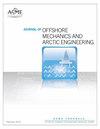LSTM与TCN模型在半潜式平台波浪起伏预报中的比较研究
IF 2.1
4区 工程技术
Q3 ENGINEERING, MECHANICAL
Journal of Offshore Mechanics and Arctic Engineering-Transactions of the Asme
Pub Date : 2023-08-28
DOI:10.1115/1.4063266
引用次数: 0
摘要
浪涌预报是海上结构物设计和早期预警的必要条件。基于机器学习的数据驱动方法激发了波-结构相互作用问题的降阶解决方案。本研究量化了深度学习算法在波浪起伏预测方面的潜力。利用两种著名的深度学习模型,预测了半潜式潜水器在头海下沿前柱的波浪起伏。基于深海盆地模型试验数据,对长短期记忆(LSTM)和时间卷积网络(TCN)进行了综合比较。优化LSTM和TCN模型结构,合理比较预测精度和计算复杂度。结果表明:(1)TCN模型和LSTM模型的预测精度均达到90%以上。他们的预测被扩展到未来10秒,准确率分别超过80%和45%。(2)在噪声扩展数据集上,LSTM模型对噪声具有较强的鲁棒性,而TCN模型对极端波峰事件的预测性能较好。(3)入射波和主导旋转为波浪起伏预报提供了主要信息。TCN和LSTM模型在简化输入波和基音张量的基础上预测精度分别为91.5%和89.3%。结果表明,TCN模型在预测非线性波动方面具有很大的潜力,而且具有较低的时间和存储成本。基于物理理解的输入张量设计和优化对预测性能也起着重要作用。本文章由计算机程序翻译,如有差异,请以英文原文为准。
A Comparative Study of LSTM and TCN Models for Semi-submersible Platform Wave Runup Prediction
Wave runup prediction is necessary for the offshore structure designs and early warnings. Data-driven methods based on machine learning have inspired reduced-order solutions for wave-structure interaction problems. This study provides the quantification of deep learning algorithms' potential for wave runup prediction. Two prominent deep learning models were utilized to predict the wave runups along the fore column of semi-submersible under head seas. The long short-term memory (LSTM) and the temporal convolutional networks (TCN) were comprehensively compared based on the datasets from a model test carried out in the deep ocean basin. The LSTM and TCN model structures were optimized to compare prediction accuracy and computational complexity reasonably. The results reveal that: (1) both developed TCN and LSTM models had satisfied prediction accuracy of over 90 %. Their predictions were extended to 10 seconds into the future with accuracies over 80 % and 45 %, respectively. (2) With the noise-extended datasets, the LSTM model was robust to noises, while the TCN model showed better prediction performance on the extreme wave runup events. (3) The incident wave and dominant rotation provided the major information for wave runup prediction. TCN and LSTM models' prediction accuracies were 91.5 % and 89.3 % based on the simplified input tensors composed of incident wave and pitch. The comparison showed the great potential of TCN model to predict the nonlinear wave runup with less time and memory costs. The input tensors design and optimization based on physical understanding also play a significant role in the prediction performance.
求助全文
通过发布文献求助,成功后即可免费获取论文全文。
去求助
来源期刊
CiteScore
4.20
自引率
6.20%
发文量
63
审稿时长
6-12 weeks
期刊介绍:
The Journal of Offshore Mechanics and Arctic Engineering is an international resource for original peer-reviewed research that advances the state of knowledge on all aspects of analysis, design, and technology development in ocean, offshore, arctic, and related fields. Its main goals are to provide a forum for timely and in-depth exchanges of scientific and technical information among researchers and engineers. It emphasizes fundamental research and development studies as well as review articles that offer either retrospective perspectives on well-established topics or exposures to innovative or novel developments. Case histories are not encouraged. The journal also documents significant developments in related fields and major accomplishments of renowned scientists by programming themed issues to record such events.
Scope: Offshore Mechanics, Drilling Technology, Fixed and Floating Production Systems; Ocean Engineering, Hydrodynamics, and Ship Motions; Ocean Climate Statistics, Storms, Extremes, and Hurricanes; Structural Mechanics; Safety, Reliability, Risk Assessment, and Uncertainty Quantification; Riser Mechanics, Cable and Mooring Dynamics, Pipeline and Subsea Technology; Materials Engineering, Fatigue, Fracture, Welding Technology, Non-destructive Testing, Inspection Technologies, Corrosion Protection and Control; Fluid-structure Interaction, Computational Fluid Dynamics, Flow and Vortex-Induced Vibrations; Marine and Offshore Geotechnics, Soil Mechanics, Soil-pipeline Interaction; Ocean Renewable Energy; Ocean Space Utilization and Aquaculture Engineering; Petroleum Technology; Polar and Arctic Science and Technology, Ice Mechanics, Arctic Drilling and Exploration, Arctic Structures, Ice-structure and Ship Interaction, Permafrost Engineering, Arctic and Thermal Design.

 求助内容:
求助内容: 应助结果提醒方式:
应助结果提醒方式:


